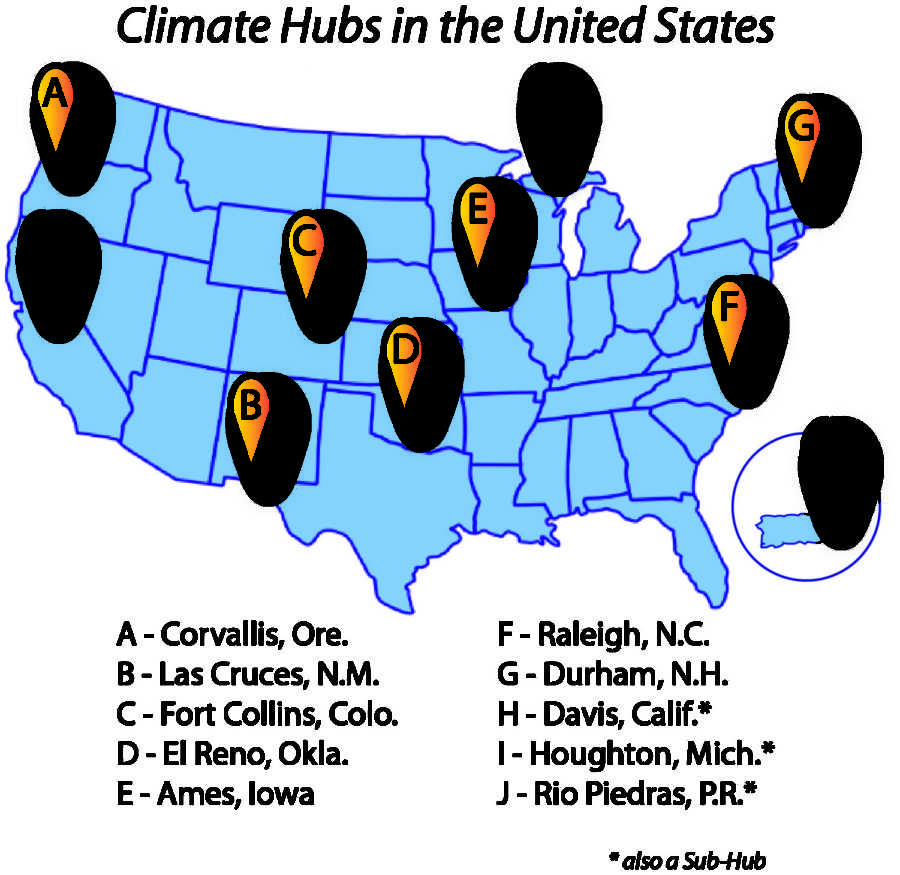City of Ames deemed new ‘climate hub’ to adapt to shifting conditions
Robert Mercer/Iowa State Daily
Climate Hub Map
February 14, 2014
Ames was named one of the country’s seven new “climate hubs” on Feb. 5, in an announcement from Secretary of Agriculture Tom Vilsack. The climate centers were created by the Obama administration in an attempt to mitigate and adapt to the effects of climate change.
“Climate hubs are part of our broad commitment to developing the next generation of climate solutions so that our agricultural leaders have the modern technologies and tools they need to adapt and succeed in the face of a changing climate,” Vilsack said.
Dr. Jerry Hatfield, collaborating professor and lab director at the National Laboratory for Agriculture and the Environment in Ames, was chosen to direct the new center.
Hatfield, who has an extensive agriculture climatology background, said the Ames hub will focus mainly on efficient communication and education in how climate change will affect agriculture.
“What the climate hub is all about is really building this integrated system between science, information and outreach to the agriculture and forest community.” Hatfield said. “Our primary audience is farmers and agribusinesses, but anybody involved with agriculture — they’re going to be looking at this.”
The climate centers, which are part of the U.S. Department of Agriculture research service, will be located in cities scattered across the United States: Ames, Iowa; Durham, N.H.; Raleigh, N.C.; Fort Collins, Colo.; El Reno, Okla.; Corvallis, Ore.; and Las Cruces, N.M. There are sub-hubs other hubs in Houghton, Mich.; Davis, Calif. and Rio Piedras, Puerto Rico.
Farmers today “face a new and more complex threat in the form of a changing and shifting climate,” Vilsack said in his statement. The Ames climate hub will try to help farmers by developing a Midwest profile. The profile will show how climate change will affect the corn and soybean industry, as well as various livestock and a few perennial crops, including cherries, apples and cranberries.
The hub, Hatfield said, will not have a separate physical presence on campus. Instead, it will be more of a virtual center, which focuses on forming links between climate researchers all over the Midwest.
The Ames hub, housed in the National Laboratory for Agriculture and the Environment, will be a coordination center, compiling information and communicating it to farmers and agribusinesses.
“Our impact is not going to come from the staff that we have here. It’s going to come because of the linkages we build across the Midwest.” Hatfield said. “Iowa State is helping us. We’re working very strongly on using their connections to open some doors for us, so they can make these climate hubs work.”
Websites are currently being developed for the new center and will be a main component of education and outreach. “It’s putting things in layman’s terms, putting things in information terms they can use,” Hatfield said. “How do we get this information so that people have an increased awareness?”
Hatfield hopes that ISU students will be involved in the Ames climate hub in numerous ways, including communicating scientific information, building the new websites and conducting research.
“It’s really about information delivery. It’s about taking information we have, putting into very usable forms and making sure that it’s applicable,” Hatfield said.

















